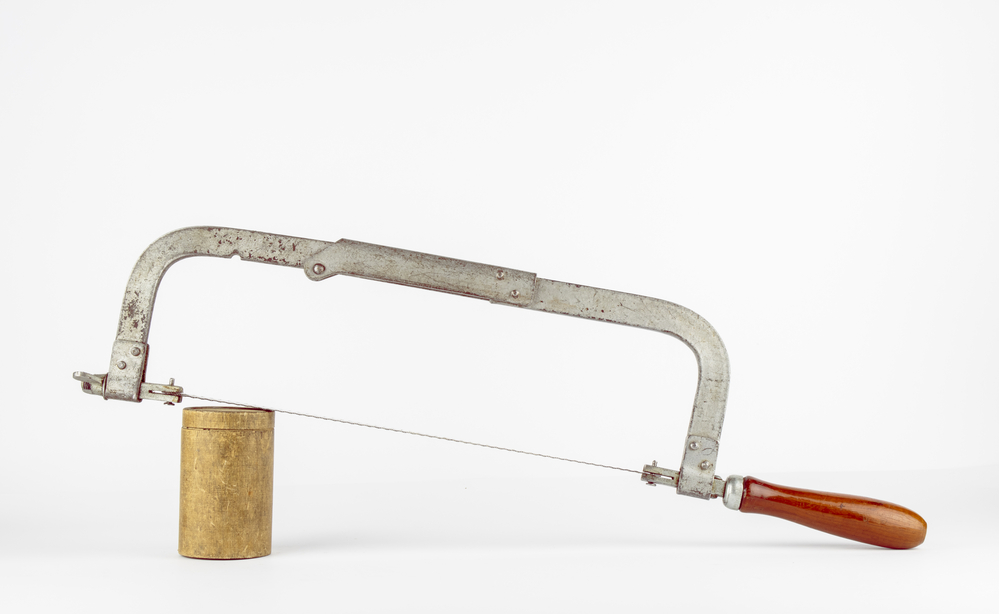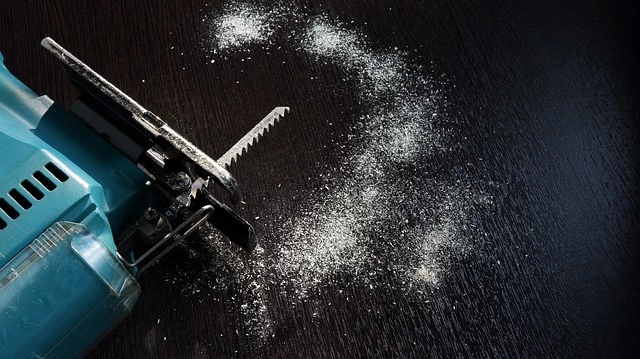Coping saws and jigsaws are similar. The difference is that a jigsaw is for irregular curves, whereas the coping saw works on simple curves. A coping saw is a narrow blade held in a C-shaped frame with a simple handle. It runs circles around any other handheld saw, even a jigsaw.
It comes with a profile of one molding, leaving an undulating cope that overlaps the adjacent trim piece’s saw profile. A jigsaw is a saw which uses a reciprocating blade to cut irregular curves, such as stenciled designs.
Coping saw vs Jigsaw
Coping saw
A coping saw is a small hand saw used to cut crown molding or other architectural shapes in wood. It cuts a curve in wood by following an existing curve. The thin, fine-toothed, flexible saw blade is 9–12 inches long.
The saw’s frame is wood, rosewood, or plastic, and the handle is usually bent so that you operate the saw with one hand. A coping saw is for complex shapes and interior cut-outs in woodworking and carpentry. It is for moldings that create coped joints. It creates fretwork, and the fret saw is for more complicated cuts.

The coping saw is for intersections and making different shapes on wooden structures. It makes oval, circular, and rectangular shapes. The tiny blade makes it accurate. A coping saw replaces the hole saw since it cuts a drilling hole on a workpiece.
Most top coping saws are easy to detach on their ends. Coping saws are for narrower cuts, intricate external shapes, and interior cut-outs in woodworking. It is for coped joints. The coping saw is better for cutting thicker material because the blade is not fragile. The metal frame that makes the saw blade makes cutting thicker materials easy.
When installing the blade, be attentive. Install the blade by setting the frame’s front edge on a bench. Hold the handle, making sure that it is pointing at you. Attach one end of the blade far from the handle.
Press down the handle as you compress the frame. That allows the blade to attach to the other hand of the saw frame. Release tension and adjust the spigot. Hold the material with clamps so that you make sure you are safe. That prevents the wood from slipping when cutting.
You open the clamp, place the material inside and tighten the clamp. Trace the line you wish to cut onto the wood. The central teeth of the saw blade have to be on the line. Push the saw in a short stroke. Keep sawing and maintain the perpendicular to the wood.
Whilst cutting, turn the handle and frame following the cut line. Several passes are needed if you are molding. If the blade breaks during operation, loosen it, replace and tighten it. Keep your hands and accessories off the sharp teeth to avoid hurting yourself.
Features of a Coping Saw
Blade
The blade is of hardened steel that stretches from one end of the square to the other. It is c-shaped, and the handle attaches to the iron frame. The blade is easy to remove. You remove it when you want the saw blade to pass through a drilled hole in the middle of the wood piece. Attach the frame back to the saw blade so that the cuts start from the middle part of the workpiece.
The blade is removed by unscrewing the handle partially. You stop the saw blade from rotating by using a steady bar where the blade is attached. A perfect alignment of the bars keeps the saw blade straight. The handle controls the blade tension and locks it at a certain angle of your choice.
Frame
The frame is shallow. That is the reason why long cuts are limited.
Jigsaw
A jigsaw is a saw with a reciprocating blade to cut irregular curves, such as stenciled designs. It cuts through wood and metal. The power tool has an electric motor and a reciprocating saw blade. If you have a jigsaw with sole plates and a beveling function, you can cut angles up to 45 degrees. What separates jigsaws from scroll saws is that they are electrically powered and portable. A jigsaw is ideal for beginners and versatile. It is quick in cutting curves.

Jigsaws cut wood of varying thickness and density. Fit with the correct saw blade to cut steel, fiberglass, and drywall. That is how valuable the saw is in your workshop.
Changing blades is easy. Unplug the saw or remove the battery and turn the dial counter-clockwise to release the saw blade. It has to allow you to insert a new one. When the dial is released, it locks the blade in place. Jigsaws are up to 45 degrees for bevel cuts.
Use a lever above the saw shoe that slides back and forth. When released, the saw will tilt to one side and pull the lever back to lock it in place. A cordless jigsaw allows you to twist and turn the jigsaw, and cut curves without being disturbed by a dangling cord or worrying about accidentally cutting it. That is a newer version, and it has a battery-powered variety, lightweight and slim.
Jigsaws are user-friendly. With the proper instruction and adult supervision, children of any age can use it. The tool rests on the surface of your material. There is no need for more strength. Fingers and hands are easy to keep clear of the blade.
Features of a Jigsaw
Blade
You can screw multiple blades into the tool. Although there is a tool-free blade change system, multiple offers allow you to set up a quick and tool-free blade change. Shank blades are standard and professional blades. They have a longer life and a tighter fit from the blade to the tool.
The tooth design determines the performance of a blade. The tooth spacing, tooth shape, and cutting angle also determine the speed and cleanliness of cuts. A side set and ground tooth makes clean and fast cuts in wood.
The teeth cut most metals as well as plastics. A side set and milled tooth work with fast and rougher cuts. A taper-ground tooth is for precise and clean cuts. It comes with reduced-kerf carbide and diamond grit edges for fast cutting in hard materials.
Motor power
A jigsaw has more cutting power with a higher amperage rating. Pick jigsaws with motor ratings of six or seven amps.
Similarities
- A jigsaw and a coping saw are hand-held saws used for cutting curves and intricate shapes in wood and other materials.
- Both saws are designed for cutting curves and shapes, making them useful for woodworking and DIY projects.
- Both saws have blades that are relatively easy to replace, saving time and hassle on projects that require multiple types of cuts.
- However, a jigsaw uses a reciprocating blade to cut through materials, while a coping saw is a handheld saw with a thin blade used for more intricate cuts.
- Jigsaws tend to be faster and more powerful than coping saws but may not offer the same level of precision and control.
Differences
- A jigsaw and a coping saw are hand-held saws used for cutting curves and intricate shapes in wood and other materials.
- One of the main differences between the two is the saw blade. A jigsaw uses a longer, thinner blade with smaller teeth suitable for cutting wood, metal, and plastic. In contrast, a coping saw uses a shorter, thicker blade with larger teeth designed for cutting curves and intricate shapes in wood.
- Durability is difficult to compare directly, as many factors can affect the life of each tool. Generally, jigsaws are designed for a broader range of sawing tasks and may have more durable blades than coping saws designed for more specific tasks.
Is a coping saw a hack saw?
A coping saw is not a hacksaw. Although they look similar in some respects, they have different designs and functions that make them more suitable for different materials and cutting tasks.
A coping saw is a type of hand saw specifically designed for cutting intricate shapes and curves in wood. It has a narrow, flexible blade attached to a U-shaped frame that can be set at different angles.
A hacksaw, on the other hand, is a type of handsaw used mainly for cutting metal and plastic pipes and other hard materials. It has a rigid frame and a fine-toothed saw blade that is tensioned to make precise cuts.
Can you use a coping saw blade on a scroll saw?
Yes, you can. However, there are some important considerations to keep in mind. Firstly, coping saw blades are typically thinner and more flexible than a scroll saw blades, which can cause them to break or bend easily when used in a scroll saw. Additionally, coping saw blades may not fit properly in the blade holder of a scroll saw, which could affect the accuracy of your cuts and potentially damage the machine.
Therefore, if you decide to use a coping saw blade on a scroll saw, you must ensure that the blade is compatible with the machine and then-ake any necessary adjustments to the tension and speed settings. Using a blade guard or other safety measures to prevent injury is also a good idea.
Are coping saw blades and scroll saw blades the same?
Coping saw blades and scroll saw blades are not the same thing. Although they are interchangeable for certain tasks, they differ significantly in their construction and purpose.
For example, scroll saw blades typically have a shallow depth and are narrow with fine teeth, making them suitable for cutting curves and intricate shapes in thin materials such as wood, plastic and metal. Coping saw blades, on the other hand, are typically thicker and have more teeth per inch, allowing them to cut through thicker materials and make smoother, more precise cuts in intricate patterns.
Is a junior hacksaw a coping saw?
A junior hacksaw is not a chop saw. They have more in common than differences. Junior hacksaws have a straight handle, just like chop saws. The handle can be turned freely, giving you more control over your cuts. The junior hacksaw is suitable for straight cuts on small, light jobs. A scroll saw usually has a deeper frame and a narrow blade that can be easily adjusted to cut intricate shapes. In comparison, a junior hacksaw has a shallower frame and wider blade that is best for straight cuts in smaller materials.
- Grain and Sheen: Teak Oil versus Danish Oil Uncovered - January 10, 2024
- The Cherry on Top: Crafting the Perfect Cutting Board - January 9, 2024
- Polyurethane Water-Based vs Oil-Based: Choosing the Right Finish - January 8, 2024